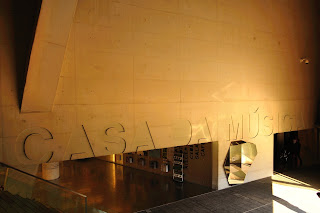domingo, 17 de outubro de 2010
Visita à Casa da Música - Porto
"Casa da Música was conceived to mark 2001, the year in which Porto was Cultural Capital of Europe, and it is the first new building in Portugal to be entirely dedicated to music - to the presentation and public enjoyment of music, to music education and to the creation of music. The project took shape in 1999 after the Rem Koolhaas & Ellen van Loon - Office for Metropolitan Architecture won the international architectural competition. Work began in 1999 on the site of Porto's former central tram garage on the Rotunda da Boavista, and Casa da Música opened its doors to the public on April 15th , 2005. Casa da Música was planned as a home for all types of music and it is not only part of the urban redevelopment of Porto but also part of a network of cultural facilities, for the city of Porto and for the wider world. Underlying it is an innovative and wide-ranging cultural project, which aims to make an exciting contribution to the national and international music scene, as an arena for all types of musical events - from classical music to jazz, from fado to electronic music, from great international productions to more experimental projects. Besides concerts, recitals and other types of performance, Casa da Música also organises events for musicians and musicologists and invests in research into the origins of Portuguese music. In addition, it plays a very important role in music education. It is a cultural meeting point between music and other areas of artistic creation and knowledge, providing a space for all kinds of audiences and creators".
"Rem Koolhaas was born in the Netherlands in 1944 and studied Architecture in London. He is one of the world's best known contemporary architects and is responsible for many prize-winning projects. These prizes have included the Pritzker Prize and the Mies van der Rohe European Union Architecture Award. In 1975 , in Rotterdam, Koolhaas created the Office for Metropolitan Architecture (OMA), which submitted the winning proposal for the Casa da Música do Porto in 1999. In 2007, Casa da Música won the Royal Institute of British Architects' (RIBA) Award, the jury describing the building as "intriguing, disquieting and dynamic". Casa da Música is surprising in terms of shape, structure, materials and functions. With its 30-metre-high entrance hall, the asymmetric building unfolds into 8 levels above ground and 3 floors below ground. With its layers of pale, exposed concrete alternating with glass, tiles and velvet, all of which contrast with the grey aluminium, smooth on the floor and perforated on the walls, and with its terraces covered with glass sunroofs and its suspended walkways, Casa da Música is undoubtedly a place that challenges visitors and invites constant discovery. The detail of the design can be seen in the fixed furniture, such as counters and seats, and in the choice of the detachable furniture. The seats in the main auditorium, Sala Suggia, include reading lights and air conditioning, and in other areas of the building can be found reissues of furniture by the Portuguese designers Daciano da Costa and Sena da Silva, together with pieces by Maarten van Severen, Leonor Álvares de Oliveira and Fernando Távora".
"Other Spaces REHEARSAL ROOMS The Casa da Música has a total of 10 rehearsal rooms of varying sizes. The two biggest rehearsal rooms, holding groups of 20 to 100 people, are located on Floor -2. They are also fully equipped with their own control rooms and can be used as recording studios.
Location: 1st Floor and Floor -2 SALA RENASCENÇA The Renaissance Room can be accessed from two points and is an area through which visitors can reach the Sala Laranja (Orange Room), the Cybermusica (the Cybermusic Room) and the Foyer Poente (West Lobby). The name of the room derives from the effect created by the blue, green and white tiles. Location: 4th Floor SALA ROXA and SALA LARANJA Sala Roxa (Purple Room) and Sala Laranja (Orange Room) are public spaces designed for educational events and are eminently suitable for activities involving young people. They are small spaces with both the floor and the walls covered in cork tiles with ceilings of foam and fabric. Location: floor 5 SALA VIP The VIP Room is a multifuncional space, mainly used for sessions for small groups, installations or ceremonial occasions. Here, Rem Koolhaas paid homage to Portuguese tiles and each of its panels is a reproduction of an original panel to be found in different museums in Portugal and the Netherlands. Location: 6th Floor TERRACE The terrace is a wide open space, divided into platforms, on one of the highest floors of the building, with a glass ceiling that opens up to the sky. Its main purpose is to serve as support for events such as conferences, public presentations or receptions. Location: 7th floor"
From: http://www.casadamusica.com/
Subscrever:
Mensagens (Atom)
